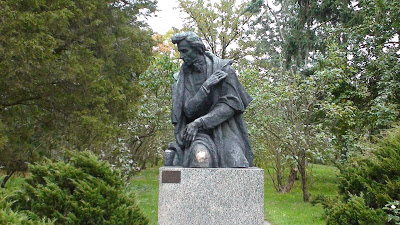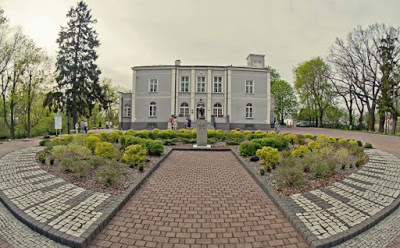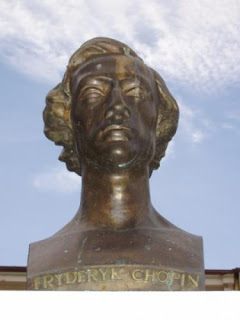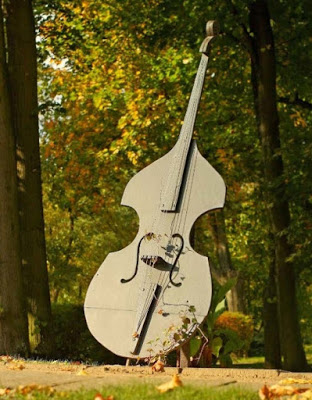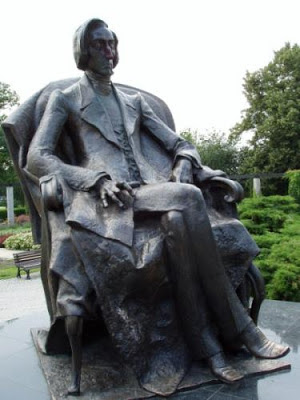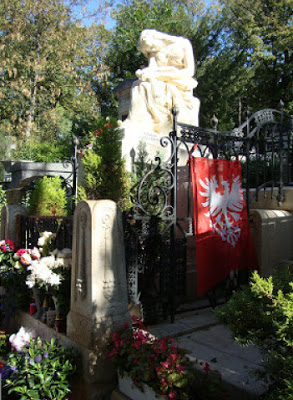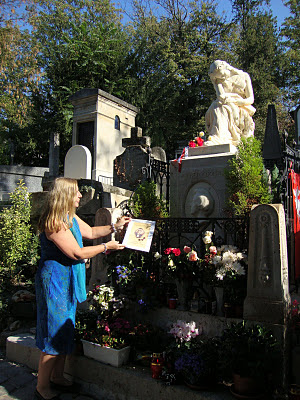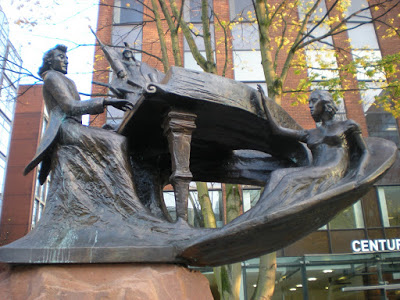In a continued Tour of Chopin Monuments Around the World that started in Warsaw a month ago, we visit other Polish cities and locations where Chopin monuments may be found.
From Warsaw we go to Chopin’s birthplace in Zelazowa Wola, to Szafarnia Manor and Park, where he spend his summer vacations, and to a Wroclaw, where he stopped on the way somewhere else. Then, we go to Paris, England, and Ukraine…
ZELAZOWA WOLA, CHOPIN’S BIRTHPLACE, POLAND
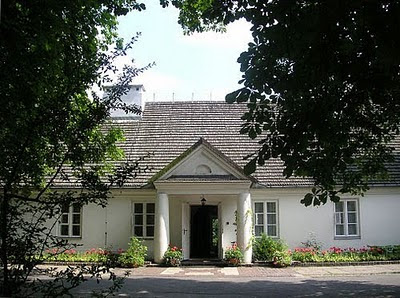
The small manor, with a typical Polish sloping roof, six-paned window, and entrance way framed by white columns, is a well known Chopin landmark. This is where Fryderyk Franciszek Chopin was born on March 1, 1810 (as celebrated by the composer and his family), though the birth was recorded in the parish registry as having happened on February 22, 1810 (this date was favored by some of Chopin aficionados from around the world)… His father, Nicolas Chopin, born in the area of Lorraine, France, came to Poland and since 1802 worked as a tutor for the four children of Count Skarbek. The eldest son, Fryderyk Skarbek was to be the God-father to the child, named after him… Now, we only hear about the younger or the older Counts Skarbek because of their connection to Chopin, not the other way around. The mother, Justyna Krzyzanowska was a poor relation and housekeeper for the Skarbek family, and, no doubt, cherished the moment of moving out of their manor to the new family’s cottage after the wedding of 1806.
Today, Chopin recitals are held outdoors all summer and tour buses stop by regularly. There are portraits, pianos, and furnishings indoors, and a beautiful park to walk through… Not everyone is aware that that park features a Chopin Monument. After visiting it numerous times and attending many concerts, I have never noticed its presence and only discovered this monument on the Internet!

Chopin Monument in Zelazowa Wola. Photo from Wikipedia
Sculpted by Józef Gosławski in 1955, the monument was unveiled in 1969 in Żelazowa Wola, Poland. The mature pianist, dressed in a coat and an evening suit with a huge bowtie seems ready to leave his homeland forever. The pianist’s beautiful hands are featured prominently holding the folds of the coat. Chopin looks away, is turned inward, lost in reflection and sorrow. The last step before leaving forever… Hidden among trees and bushes of the park, this sculpture deserves to be better known.
Another view of the monument in its park setting. Photo from Wikipedia, by Adam Rudzki
SZAFARNIA PALACE NEAR TORUN
There is a monument to Chopin at the Szafarnia Palace where he stayed for holidays with a school friend in 1824 and 1825. Then, owned by Julian Dziewanowski, the father of Chopin’s friend Dominik („Domus”), and located near Torun in central Poland, the house and grounds provided the young composer with healthy diversions and many opportunities to encounter Polish folk dances and music. The Chopin bust is placed at the entrance to the Szafarnia Palace, now a Center of Chopin Studies. The setting is very interesting, with the sidewalk paved to represent a curved keyboard.
Chopin Monument in Szafarnia. Photo from Google Maps, 2014
Chopin Monument in Szafarnia. Photo from NIFC website
The romantic portrait of a „genius composer” with windswept hair requires no further comments… But we are delighted to note the presence of a large „basetla” – a string bass string used in folk ensembles, „kapela” that played the obereks, mazurkas, and kujawiaks that so impressed the young composer. During the summer of 1825, he actually had a chance to play the instrument during the Harvest Festival held at Szafarnia, after the procession of the villagers reached the manor, and other elements of the festival have concluded, with singing, dancing, gift presentation and games… This is how Chopin described this monumental occasion in a letter to his parents in Warsaw, dated August 26, 1825:
Już była prawie 11-nasta, gdy Frycowa basetlę przynosi, gorszą od skrzypcy, o jednej tylko stronie. Dorwawszy się zakurzonego smyka jak zacznę bassować, takiem tęgo dudlił, że się wszyscy zlecieli patrzeć na dwóch Fryców, jednego śpiący na skrzypkach, drugiego na jednostronnej, monokordycznej, zakurzonej […] rzępolącego basetli,
„It was almost elevent when the wife of Fryc brings a basetla (string bass) worse than the violin (fiddle), and with only one string. After grabbing the dusty bow, I started playing the bass with such fervor, I made noise with such intensity that everyone came up to see the two Fryces (Fryderyk’s nickname), one sleeping on the violin, the other on the one-stringed, monochordial, dusty and noisy basetla…”.
Sculpture from Szafarnia Park. Photo from Google Maps. October 2013
WROCLAW, POLAND
Chopin did not stay in the City of Wroclaw for an extended period, but traveled through it four times when going to the cure in the spa of Duszniki (then: Reinhert). In a letter from the summer of 1826, to his friend Wilhelm Kolberg, he described the route in the following words:
Kochany Wilusiu! Przejechawszy Błonie, Sochaczew, Łowicz, Kutno, Kłodawę, Koło, Turek, Kalisz, Ostrów, Międzybórz, Oleśnicę, Wrocław, Nimsch, Frankenstein, Wartę i Glatz, stanęliśmy w Reinertz, gdzie dotąd stojemy. — Dwa tygodnie już piję serwatkę i wody tutejsze; i niby, jak mówią, mam trochę lepiej wyglądać, mam niby tyć, a tym samym lenieć…
„My dear Wilus! After having traveled through Błonie, Sochaczew, Łowicz, Kutno, Kłodawa, Koło, Turek, Kalisz, Ostrów, Międzybórz, Oleśnica, Wrocław (then: Breslau), Nimsch, Frankenstein, Warta and Glatz, we stopped in Reintertz, where we are staying now. For two weeks already I have been drinking whey and the local waters, and as they say, I am supposed to look better, and I’m supposed to gain weight, and at the same time become more lazy…”.
Four years later, we find Chopin in Wroclaw again, this time visiting the city itself, staying in an inn, attending a performance (as described on the NIFC website): „Only in November 1830 did he stay in the city for a longer time. On that occasion, he and Tytus Woyciechowski stayed at the Zur Goldenen Gans [The golden goose] inn on Junkernstrasse (now Ofiar Oświęcimskich street). In the evening of their arrival they went to the Municipal Theatre on Taschenstrasse (now at the junction of Oławska and Piotra Skargi street) for a performance of Raimund’s Der Alpenkönig und der Menschenfeind„.
The composer described his impromptu performance Wrocław in a letter written on 9 November 1830:
„I found there a small, as usual, orchestra that had turned up for the rehearsal, a piano and some referendary, an amateur, by the name of Hellwig, preparing to play the First Concerto in E flat major by Moscheles. Before he sat down at the instrument, Schnabel, who had not heard me for four years, asked me to try out the piano. It was difficult to refuse, so I sat down and played a couple of variations. Schnabel was infinitely pleased, Mr Hellwig got cold feet, and others began to request that I perform in the evening. More particularly, Schnabel so kindly insisted that I couldn’t dare refuse the old gentleman. He’s a great friend of Mr Elsner’s; but I told him that I’d do it just for him, since neither had I played for a couple of weeks, nor was I intending to show off in Wrocław. To that the old man said that he knew all of this and that he had wanted to ask me yesterday in the church, but was too embarrassed. Then I went with his son to get some music and played them the Romance and Rondo from the Second Concerto”.
The monument captures the composer resting in an armchair, with eyes closed, listening to the music, maybe, during that rehearsal… As elegant as every, he seems much taller and more imposing than in real life. That’s what monuments do: monumentalize their subjects!
Photo from NIFC website
KIEV, UKRAINE
It is perhaps due to the unwillingness of sculptors to compete with the epic monument by Szymanowski, located in the Lazienki Park in Warsaw, that so many Polish sculptures in Poland are of his head, or bust, or, if full-scale figures present the piano-less composer ready to leave his country, or resting, listening to music…
The new Chopin monument in Kiev, Ukraine, follows another path: it is a „Chopin-less” white piano, filled with flowers, and standing on a sidewalk with one leg planted in the grass. I am not sure whether this moument is a permanent sculpture or a temporary installation. But I’m sure it is quite cute and does attract the attention of passers-by… There were no Chopin visits, letters, or historical occasions to commemorate. There was and is only music…
This photo of Chopin Monument is courtesy of TripAdvisor.
Kyiv: „A Piano in the Bush” – Chopin Monument (Cora_v, Jun 2014)
PARIS, FRANCE
Chopin’s tombstone in the Père Lachaise Cemetery, Paris, featuring the muse of music, Euterpe, weeping over a broken lyre, was designed and sculpted by Auguste Clésinger, the husband of Solange Dudevant, daughter of George Sand (Baroness Aurore Dudevant), Chopin’s lover. Visitors keep leaving mementos and the tomb is among the four most often visited tombs in the entire cemetery, sharing the honors with Jim Morrison, Oskar Wilde, and Edith Piaf… Bellini or Rossini, in contrast, are forgotten. Such is the power of the personal, intimate language of Chopin’s music that speaks directly to the heart…

There is no end to the supply of fresh flowers, mementos and gifts, that include piano keys, candles, poems, and books… The tombstone features a portrait of Chopin seen from the side; this cameo-like profile places Chopin in the domain of the „immortals”. Yet, the bouquets of roses, carnations and other flowers are checked and changed daily. The vases are provided by a local Polish committee and the tombstone is appropriately decorated with red-and-white Polish colored ribbons and flags.
I leave a copy of Chopin with Cherries at the Chopin Tombstone in Paris
Here is a selection of poems from Chopin with Cherries, reprinted by the Cosmopolitan Review. Elizabeth Murawski wrote about visiting Chopin museum and seeing the memorabilia kept there, so let us cite her poem:
Polonaise
By Elisabeth Murawski
In the museum, along
with first editions,
the death mask, the chair
whose arms he gripped
in coughing fits,
a lock of yellow hair.
Was it Sand who clipped it
for a keepsake? She
who whispered
Let me be your lightning rod
as Chopin played
for her ears only,
courting the angels,
stealing the shine
from the Seine. Think
of his wish (a drastic
death certificate)
to have his body opened
that I not be buried alive,
of his heart taken home
to a Warsaw church,
of the grave in Père Lachaise
brilliant with roses
and candles, baskets
laden with fruit, of notes
plucked from his roots
that go on singing.
(c) 2010 by Elizabeth Murawski
For those who would like to read more Chopin poems, the entire anthology is recommended.
Fifty years later, at the height of fin-de-siecle expressive and decorative style of art nouveau, another portrait of Chopin was made and built in Paris in 1906. Jacques Froment-Meurice designed a scene with the elegant Chopin at the piano. The sculpture brings music to life, with an angel floating above the keyboard, and a female figure reclining at the feet of the pianist, lost to the world in rapture… This fascinating sculpture, an essay about the meaning of the music may be found at Parc Monceau – in the 8th arrondissement, at the junction of Boulevard de Courcelles, Rue de Prony and Rue Georges Berger (35 Boulevard de Courcelles, 75008 Paris).
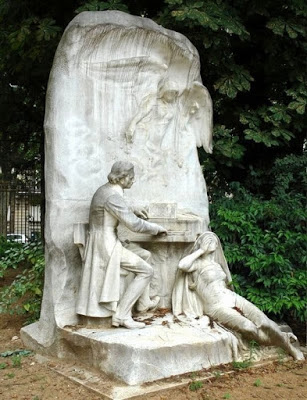
LONDON, U.K.
While the images of Chopin in France are either romantic or post-romantic, and very expressive in their flowing lines, sorrow, and intensity of music-induced ecstasy, the two sculptures found in the United Kingdom are stark and modern. In one, Chopin is sliced into an abstract figure of many layers, in another, his piano is transformed into a sled, taking off on a cosmic flight…
According to information I found on the website of the Polish Heritage Society in London, „The statue, a gift of the Polish people to the British nation for its help in fighting Nazi tyranny and originally erected on this site in 1975, was restored by the Polish Heritage Society and unveiled on 18th May 2011 by HRH the Duke of Gloucester in the presence of The Ambassador of the Republic of Poland to the United Kingdom, Her Excellency Ms Barbara Tuge-Erecińska”.
Furthermore, the report continues: „Chinese pianist Lang Lang laid flowers at the newly-unveiled statue of Fryderyk Chopin, on Sunday 22nd May, outside London’s Royal Festival Hall at the Southbank Centre to pay his respects to the Polish composer he describes as the ’perfect balance between romantic and classic’”.
Nice, very nice…
MANCHESTER, U.K.
The top prize for the strangest Chopin monument visited so far goes to… the Sobocinski’s sculpture built in 2011 in Manchester, U.K. According to a report in the Pianist Magazine,
„Commissioned by The Chopin Memorial Monument Committee and The Polish Consulate, with Bruntwood as principal sponsor, the impressive monument marks the culmination of the celebrations of the bicentenary of Chopin’s birth. The creation of Polish sculptor Robert Sobocinski, the sculpture is a fitting tribute to the composer’s genius and marks the occasion when he performed in Manchester in 1848, shortly before his death. The work depicts Chopin at the piano gazing across at his muse Baroness Aurore Lucile Dupon. Carved into the work is an eagle in flight – the symbol of Poland for over one thousand years and a battle scene symbolising the Polish fight for freedom. The monument measures 4 metres high and 2.5 metres wide and is set on a sandstone plinth”.
According to a blogger Chrissy Brand, „this recently unveiled monument of Fryderyk Chopin stands in Deansgate at the edge of the city centre’s main shopping district. It marks the occasion when the Polish genius performed in Manchester in August 1848 at the Gentleman’s Concert Hall, despite his failing health. Chopin died not long afterwards aged 39”.
Well, what can we say after that? The piano as the sled, the muse sitting at one of the ski-like appendages? The flags and national emblems waving on the other side? There is such a thing as an artistic overkill – too much food will make your sick, too much symbolism will make you dizzy. However, strange, it is better to have this monument up in the streets of Manchester, than not to have one at all. And even that female figure sitting at the bottom, below the body of the instrument has a historical justification: this is how George Sand loved to listen to Chopin playing the piano in Nohant: by lying down under the instrument, awash in waves of sound…
Pierwotnie tekst ukazał się na blogu Mai Trochimczyk.
Serdecznie dziękujemy Autorce za zgodę na jego przedruk.


